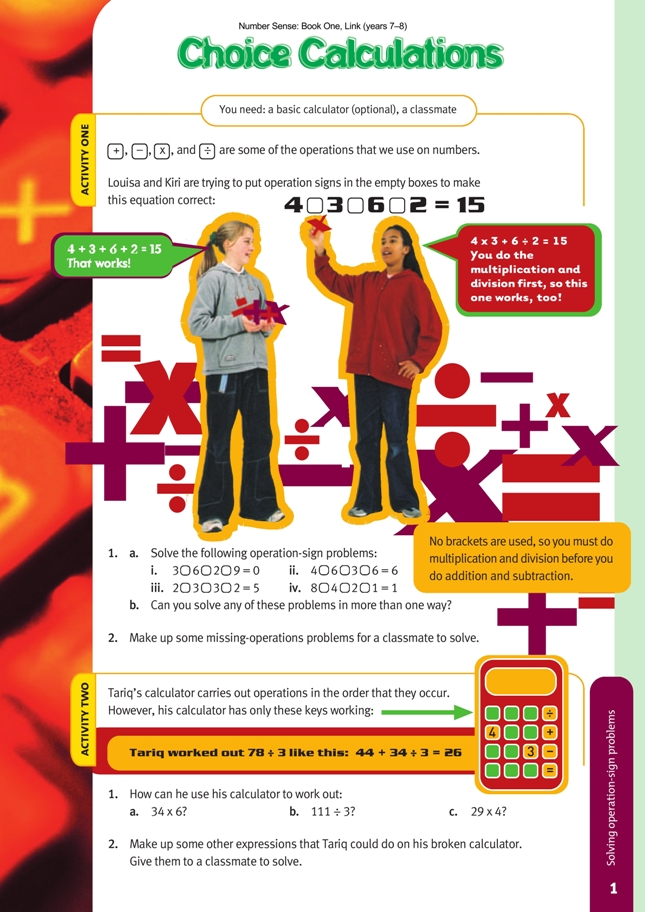This is a level 3 number activity from the Figure It Out series. It relates to Stage 6 of the Number Framework.
A PDF of the student activity is included.
Click on the image to enlarge it. Click again to close. Download PDF (588 KB)
use basic facts knowledge to solve operation-sign problems
FIO, Link, Number Sense, Book One, Choice Calculations, page 1
A classmate
Activity One
These problems are designed to encourage students to use flexible thinking with number operations to find a solution. The numbers involved have been kept small so that the students can focus on trying out different operations rather than being sidetracked by difficult calculations. The problems also reinforce the order of
operations rules that apply to equations where multiplication or division is combined with addition or subtraction. There are no brackets or exponents used in this activity, so the BEDMAS rules are used only in a limited way. (The acronym BEDMAS signifies the order in which operations should be carried out in an equation: brackets, exponents, division and multiplication in the order that they occur, and then addition
and subtraction in the order that they occur.) Draw the students’ attention to the rule in question 1a.
Present the problems as a challenge and look for opportunities to give feedback such as “Yes, Sam has found one that works!”
One approach is for the students to insert signs randomly into each equation and see what results they get.
They can then use these results to give them clues for further attempts.
Encourage the students with prompts such as “This equation gave an answer that was too large, so what could you change to get closer to the target?”
One result for question 1a i could be 3 – 6 x 2 + 9. For this answer, the students need to understand that it is possible to have a negative quantity. Students who have been taught ideas such as “You can’t take 12 away from 3” will need to be shown that you can in fact do it using negative quantities.
In question 2, insist that the students work out for themselves at least one result for each equation they make up. Otherwise they may produce some that are too difficult or tedious for their classmates to attempt.
Activity Two
This is an example of a genre of problems known as “broken calculator problems”. In these problems, the students need to rethink the numbers and operations used in a problem to give them an equivalent result. By doing this, they build on their understanding of the relationships between numbers and operations and develop their fluency with part-whole strategies.
Make sure that the students understand which keys can be used. It is also important for them to know the way basic calculators handle the order of operations. Basic calculators work out equations in the order in which the operations are entered. In terms of BEDMAS, you could say that basic calculators are programmed to automatically put brackets around numbers as they are entered. For example, if a student enters 33 – 4 x 4 = on a basic calculator, it will read this as (33 – 4) x 4 =. To encourage their awareness of this process when they are combining addition or subtraction with multiplication or division, it is good practice to have the students use brackets when recording on paper the sequence of keypad entries that they used on a basic calculator.
Scientific calculators have bracket keys so that the user can group numbers together anywhere in a sequence, as we do when we follow the order of operations rules with equations such as 33 – (4 x 4) = ". To solve this equation on a basic calculator, a student has two options: they could start by solving 4 x 4 and then entering 33 – 16 = , or they could use the memory keys in the sequence 4 x 4 M + 33 – MR = . (On some calculators, this button is named MRC instead of MR.)
Answers to Activity
Activity One
1. a.–b. Answers will vary. Possible answers include:
i. 3 x 6 – 2 x 9 = 0, 3 – 6 x 2 + 9 = 0, or 3 x 6 ÷ 2 – 9 = 0
ii. 4 x 6 – 3 x 6 = 6
iii. 2 x 3 – 3 + 2 = 5, 2 + 3 ÷ 3 + 2 = 5, or 2 – 3 + 3 x 2 = 5
iv. 8 ÷ 4 ÷ 2 ÷ 1 = 1, 8 – 4 – 2 – 1 = 1, or 8 ÷ 4 – 2 + 1 = 1
2. Problems will vary.
activity two
1. Solutions may vary depending on the type of calculator and the approach used. Possible calculations are:
a. 34 + 34 + 34 + 34 + 34 + 34 or 34 + 34 = = = = =
(or on some calculators, 34 + + 34 = = = = =)
b. 444 – 333 ÷ 3 = or 333 ÷ 3 ÷ 3 =
c. 33 – 4 + 33 – 4 + 33 – 4 + 33 – 4 =
2. Expressions will vary.
